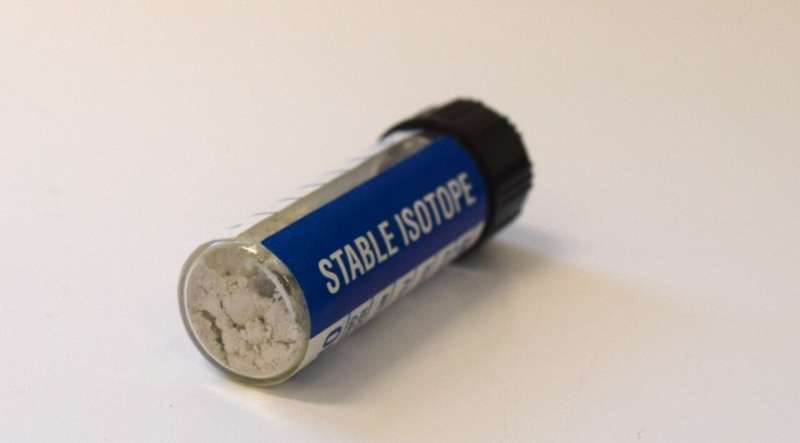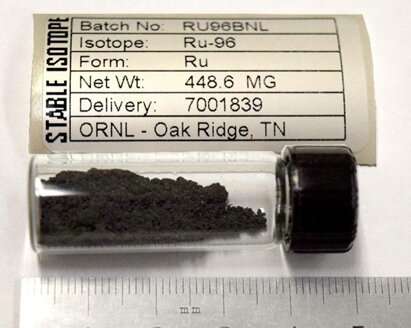This article has been reviewed according to Science X's editorial process and policies. Editors have highlighted the following attributes while ensuring the content's credibility:
fact-checked
trusted source
proofread
An electromagnetic isotope separator that continues to improve

Oak Ridge National Laboratory (ORNL)'s electromagnetic isotope separator, or EMIS, made history in 2018 when it produced 500 milligrams of the rare isotope ruthenium-96, unavailable anywhere else in the world.
And EMIS technology just keeps getting better, said Brian Egle, who heads the Enrichment Science and Engineering Division's Stable Isotope Research, Development and Production Section.
"It's capable of, essentially, separating the whole periodic table," he said.
In an EMIS, elements are put into gas form and positively electrically charged, then put through a magnetic field, which separates them by mass. Each isotope, having a different weight, travels through the field at a slightly different radius, allowing the different isotopes to be collected separately.
The technology was developed to fill a gap left by the 1998 closure of the Manhattan Project-era calutron facility at Y-12, which produced the now-dwindling U.S. stockpile of stable isotopes. EMIS development is intended to reduce U.S. dependence on foreign suppliers for rare, hard-to-produce stable isotopes. EMIS now can match or exceed the quality of isotopes produced at the calutrons.
Egle came to ORNL in 2010 to work on the first-generation of EMIS, still in use at the lab. He's since worked on second- and third-generation EMIS—each better than the last, he said.
While the original EMIS could separate isotopes of any element at decent resolution, the third-generation machine is optimized for separating elements at the heavier end of the periodic table, such as ytterbium, whose isotope Yb-176 is used in nuclear medicine and radiography.
Moreover, it can separate all the isotopes of ytterbium simultaneously, whereas the calutrons went through a series of separations and were able to capture only every other isotope—even or odd numbers.
Other isotopes of ytterbium, for example, are used in quantum memory, Egle said. EMIS-3 can produce them all. That's important because particular isotopes with no previously known use may be crucial in the future.
"Things that were not the target isotope 40 years ago that we have in inventory can all of a sudden become the enabler for future science," Egle said. "We absolutely never throw any isotopes away if we can help it."

Unlike the calutrons, EMIS are automated, so the associated labor cost is expected to be lower. And while the calutrons were linked together, each EMIS can run independently, so multiple isotopes can be produced at the same time—for example, a medical isotope alongside a national security isotope such as nickel-63, used for detecting explosives at airports.
"At DOE's discretion, we could have three machines running ytterbium, three running nickel, and one running a small amount of a rare isotope needed for research," Egle said. "They're all independent machines that can be doing independent missions in the same facility simultaneously."
EMIS features prominently in plans for the Stable Isotope Production and Research Center, or SIPRC, a new facility under construction now and expected to be operational by 2030. Its flexibility makes it a perfect complement to the gaseous centrifuge isotope separators, or GCIS, the lab is developing for multiple isotopes. Self-sufficient GCIS, which also will be used in SIPRC, can produce high volumes of isotopes at a low cost. But changing GCIS from one isotope to another is a process that can take years, whereas EMIS can switch from producing one isotope to another in a matter of weeks.
"The EMIS fills a boutique, niche market: milligrams-to-grams scale at very high enrichments, with high flexibility where we can switch across the whole periodic table relatively rapidly," Egle said.
Development of EMIS-3 went smoothly, Egle said, because of adequate funding—including the renovation of a facility specifically for its production—and because of the expertise and skilled workforce ORNL grew while developing the first two generations.
"We didn't just copy this out of a book," he said. "This is knowledge that we've built and a knowledge base that can be taken to the next level, whatever the next level is."
The lab also has established relationships with vendors to produce the ORNL-designed components for EMIS-3. Egle said parts for the technology come from as near as a small, family-owned electronics company in nearby Blount County, and as far away as an electromagnet facility in New Zealand. Vendors send fully integrated modules to ORNL to be assembled into the complete machine.
"The nice thing about EMIS-3 is that it's a very solid platform for further development," Egle said. "It's extremely modular, and that gives the design a lot of flexibility. When you're looking at the whole periodic table, flexibility is very important. If we need to add additional safety engineering controls for different toxicities or hazards, that's easily done."
Egle is excited about the potential for future generations of EMIS—and for that matter, about ORNL's stable isotope program in general.
"The stable isotope program is absolutely fascinating; it enables so many different things," he said. "You get to come to work and say, 'Do I want to work on curing cancer, basic science, national security…?' You can pretty much touch it all during the course of a day in the stable isotope program. You can see that in our staff. People say, 'Wow, you guys are very excited about what you do.' It's easy to get excited about a mission space like that."
Provided by Oak Ridge National Laboratory



















